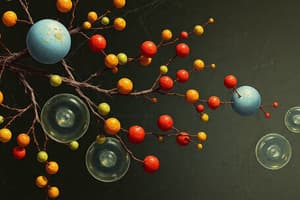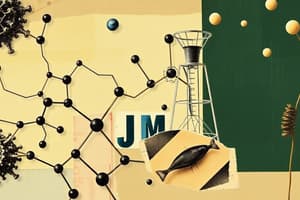Podcast
Questions and Answers
Which of the following macromolecules is NOT one of the four that make up living things?
Which of the following macromolecules is NOT one of the four that make up living things?
- Steroids (correct)
- Nucleic acids
- Lipids
- Carbohydrates
What process is specifically referred to as the sharp change in form that occurs during an organism's development?
What process is specifically referred to as the sharp change in form that occurs during an organism's development?
- Evolution
- Metabolization
- Reproduction
- Metamorphosis (correct)
Which of the following levels is NOT part of the hierarchical organization of living systems?
Which of the following levels is NOT part of the hierarchical organization of living systems?
- Species
- Organelles (correct)
- Cells
- Macromolecules
Which statement about DNA is correct?
Which statement about DNA is correct?
What term refers to the ability of organisms to respond to environmental stimuli?
What term refers to the ability of organisms to respond to environmental stimuli?
What are the four types of macromolecules that make up living organisms?
What are the four types of macromolecules that make up living organisms?
How does DNA contribute to the genetic program of living organisms?
How does DNA contribute to the genetic program of living organisms?
What role does metabolism play in living systems?
What role does metabolism play in living systems?
Describe the concept of hierarchical organization in living systems.
Describe the concept of hierarchical organization in living systems.
What is meant by environmental interaction in the context of living systems?
What is meant by environmental interaction in the context of living systems?
Flashcards are hidden until you start studying
Study Notes
General Properties of Living Things
- Living systems are characterized by unique and complex molecular organization, distinguishing them from non-living systems.
Chemical Uniqueness
- Macromolecules are the large, complex molecules that comprise living systems.
- The four primary macromolecules in living organisms are:
- Lipids
- Carbohydrates
- Proteins
- Nucleic Acids
Complexity and Hierarchical Organization
- Living organisms exhibit a structured hierarchy of complexity, arranged in levels such as:
- Macromolecules
- Cells
- Organisms
- Populations
- Species
Reproduction
- An essential property of living systems is their ability to reproduce, ensuring the continuation of their species.
Possession of a Genetic Program
- Living organisms possess a genetic program that guarantees fidelity in inheritance.
- DNA, composed of long chains of nucleotides, serves as the primary storage for genetic information.
- Each nucleotide consists of a sugar, a phosphate group, and a nitrogen base.
Metabolism
- Metabolism encompasses processes such as:
- Digestion
- Energy recovery (respiration)
- Synthesis of vital molecules and structures.
- Physiology is the study of metabolic functions across various levels, from biochemical processes to overall organismal function.
Development
- All organisms undergo a life cycle that includes distinct stages of development.
- Metamorphosis refers to significant morphological changes that occur during an organism's development.
Environmental Interaction
- Ecology is the study of how organisms interact with their environments.
- Irritability, a fundamental characteristic of all living beings, refers to their ability to respond to environmental stimuli.
Movement
- Living systems demonstrate precise and controlled movements generated internally, showcasing their active nature.
General Properties of Living Things
- Living systems are characterized by unique and complex molecular organization, distinguishing them from non-living systems.
Chemical Uniqueness
- Macromolecules are the large, complex molecules that comprise living systems.
- The four primary macromolecules in living organisms are:
- Lipids
- Carbohydrates
- Proteins
- Nucleic Acids
Complexity and Hierarchical Organization
- Living organisms exhibit a structured hierarchy of complexity, arranged in levels such as:
- Macromolecules
- Cells
- Organisms
- Populations
- Species
Reproduction
- An essential property of living systems is their ability to reproduce, ensuring the continuation of their species.
Possession of a Genetic Program
- Living organisms possess a genetic program that guarantees fidelity in inheritance.
- DNA, composed of long chains of nucleotides, serves as the primary storage for genetic information.
- Each nucleotide consists of a sugar, a phosphate group, and a nitrogen base.
Metabolism
- Metabolism encompasses processes such as:
- Digestion
- Energy recovery (respiration)
- Synthesis of vital molecules and structures.
- Physiology is the study of metabolic functions across various levels, from biochemical processes to overall organismal function.
Development
- All organisms undergo a life cycle that includes distinct stages of development.
- Metamorphosis refers to significant morphological changes that occur during an organism's development.
Environmental Interaction
- Ecology is the study of how organisms interact with their environments.
- Irritability, a fundamental characteristic of all living beings, refers to their ability to respond to environmental stimuli.
Movement
- Living systems demonstrate precise and controlled movements generated internally, showcasing their active nature.
Studying That Suits You
Use AI to generate personalized quizzes and flashcards to suit your learning preferences.



